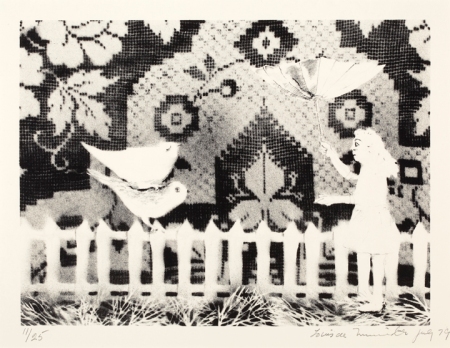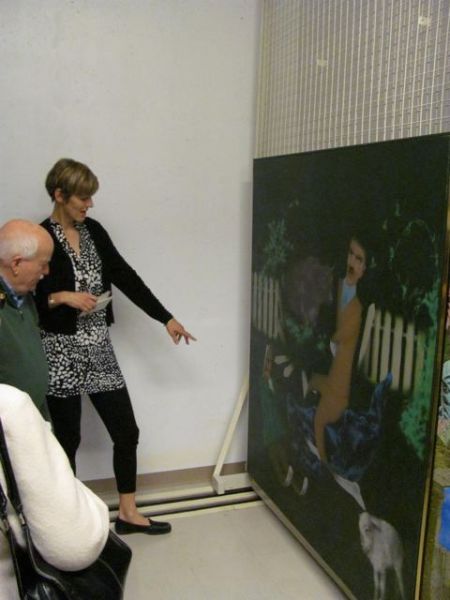“Hot Topics” blog posts come from the desk of Sam Mogelonsky, our Communications & Social Media Coordinator.
The RMG caught up with Running on Empty’s guest curator Heather Nicol for a quick chat about the exhibition and her artistic practice.

RMG: Firstly, please tell us a bit about who are you and your curatorial/ artistic practice?
Heather Nicol: I’m an artist and independent curator based in Toronto. I’ve created exhibitions for gallery spaces, but more often I work in what might be considered off-site locations, such as underutilized or repurposed urban spaces. My installations often are cited in public places, such as large atriums or, for example, in the great Hall of the Union station. Also in unusual exhibition venues, such as an crumbling rail terminus in Buffalo, a three-story carriage house in upstate New York, or in a château, in France. I am very excited about a large-scale public art project coming up in March, in lower Manhattan’s Winter Garden, an enormous barrel vaulted interior space opposite the new World Trade Center.
RMG: What was the inspiration behind Running On Empty? Oshawa has a long history with the car – does this play into your exhibition at all?
HN: Architecture or geography serve as a point of departure in my curatorial work. I am interested in ways that the histories and physical properties of exhibition spaces impact the reception of the art that is presented in them.
So, yes, Oshawa’s, and the Robert McLaughlin Gallery’s history with the automobile industry afforded me the opportunity to pursue an idea that had been percolating concerning cars as a mediating force in our relationship with the landscape.
RMG: How did you select the artists in the exhibition?
HN: I seem to have a strange habit of keeping a lookout for potential off-site exhibition venues as I go through life, whether it’s a vacant warehouse or decommission school. I have thought that a wonderful old-fashioned gas station near where I live would be a terrific place to create a show about cars, and have kept an eye on it for years, wondering it it might close or be up for rent. Ironically, it’s up for rent right now!
From from the beginning of my thinking about this show, I hoped to include the famous traffic jam sequence from Jean-Luc Godard’s 1967 film “Weekend”. I saw the film in my early 20s, and that particular imagery has apparently been tucked away in my mind for years. It is quite fantastic.

Early on, I thought of some of the artists that are in Running On Empty, including Kim Adams and John Massey. I met Elinor Whidden while on a residency in Newfoundland, and Ioved the way she links cars and highways with historical notions of landscape. Her work inspired a shift in my musings about this possible show, away from auto bodies, toward the idea of the car as transportation device, particularly in relationship to the vast landscapes of Canada. I have previously worked with Monica Tap and Seth Scriver, both of whom have works that are very well suited to this idea – Seth’s film was made in collaboration with Shayne Ehman. I saw Asphalt Watches at its premier at TIFF, and was especially enthusiastic about the way it links with the Godard movie. I was interested in locating an artist who worked with taxidermy animals, in part inspired by a close friend’s terrifying account of hitting a bear, and the ensuing encounter with the animal’s body. It was through online research that I discovered Montreal based Kate Puxley, whose work “TransCanada” is a wonderful addition to the project.
RMG: We love the exhibition play list – can you please tell us more about it?
HN: It began with the titles for the show, Running On Empty, which is a 1977 song by Jackson Browne. That tune captures the groove of road trips, and for me, memories of listening to songs on car radios. At the same time, it refers to the ominous under belly of our relationship to cars – our reliance on fossil fuels, the environmental impacts, etc. The idea of running out of gas, both figuratively and metaphorically, seemed perfect for this show.
Last fall I spent an enjoyable afternoon with three dear friends with whom I took a road trip to the Maritimes thirty years ago. It was actually a cycling trip, but who’s counting wheels! the four of us began brainstorming the rich history of songs on the subject. Solidifying this spontaneous list-making experience, with the song’s names hastily written on paper towel, into a document for the exhibition catalogue felt like a wonderful extension of the way I approach curating, which is from the position of an artist. I take pleasure in bringing form to whimsical notions, and hope our readers will enjoy it. The playlist is not historically researched, it is a simple expression of our collective memories at that particular moment in time.

Images
Stills from film Asphalt Watches, Shayne Ehman and Seth Scriver
Monica Tap, One-second Hudson no. 4, 2007
Kate Puxley, from the series Trans-Canada, 2011-ongoing





















